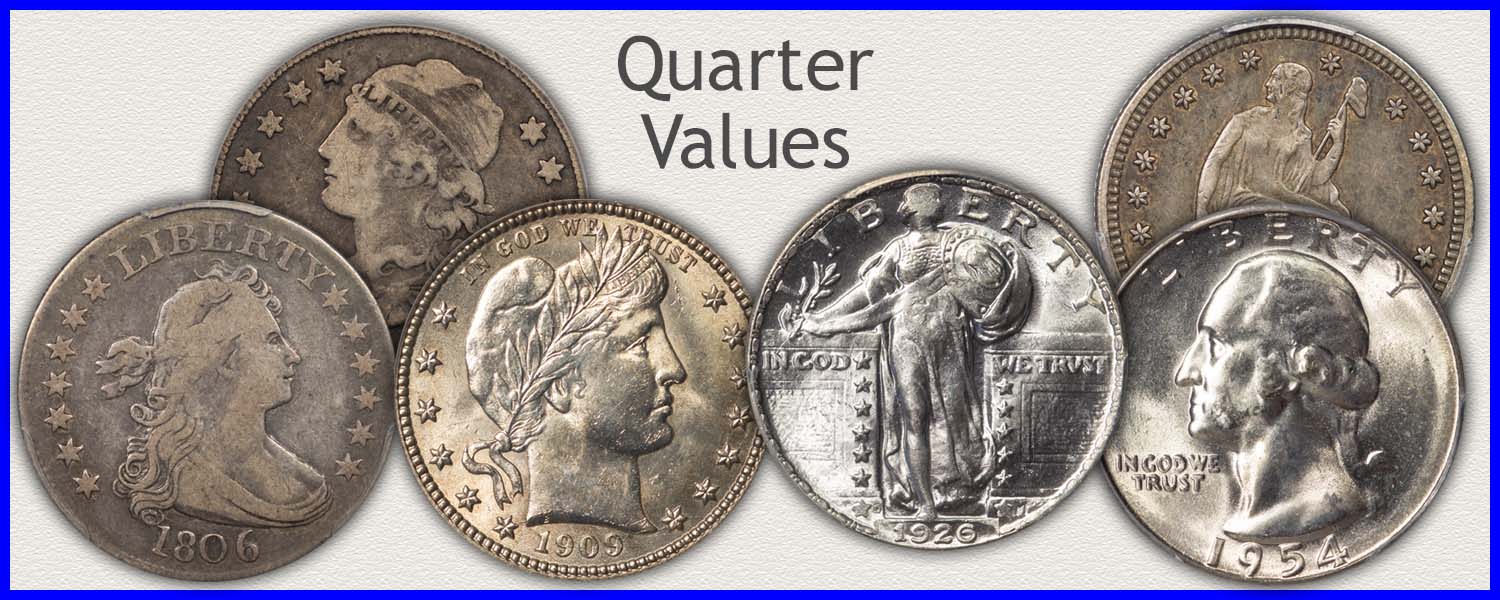Coin Values Moving with Precious Metals: Up-Dated 4/7/2025: Gold $3035 | Silver $30.08
Standing Liberty Quarter Values
Standing Liberty quarter values begin in the range of $5.69 and above. This is for a common, later date coin in the heavily worn "Good" condition. Silver today (4/7/2025 ) is in the $30.08 range supporting how much a Standing Liberty quarter is worth.
A step by step method is used to identify premium collector quality coins. Separating the bullion coins from high demand examples. Dates, mintmarks, and varieties are determined and condition is next to judge.
These steps are found below the value chart.
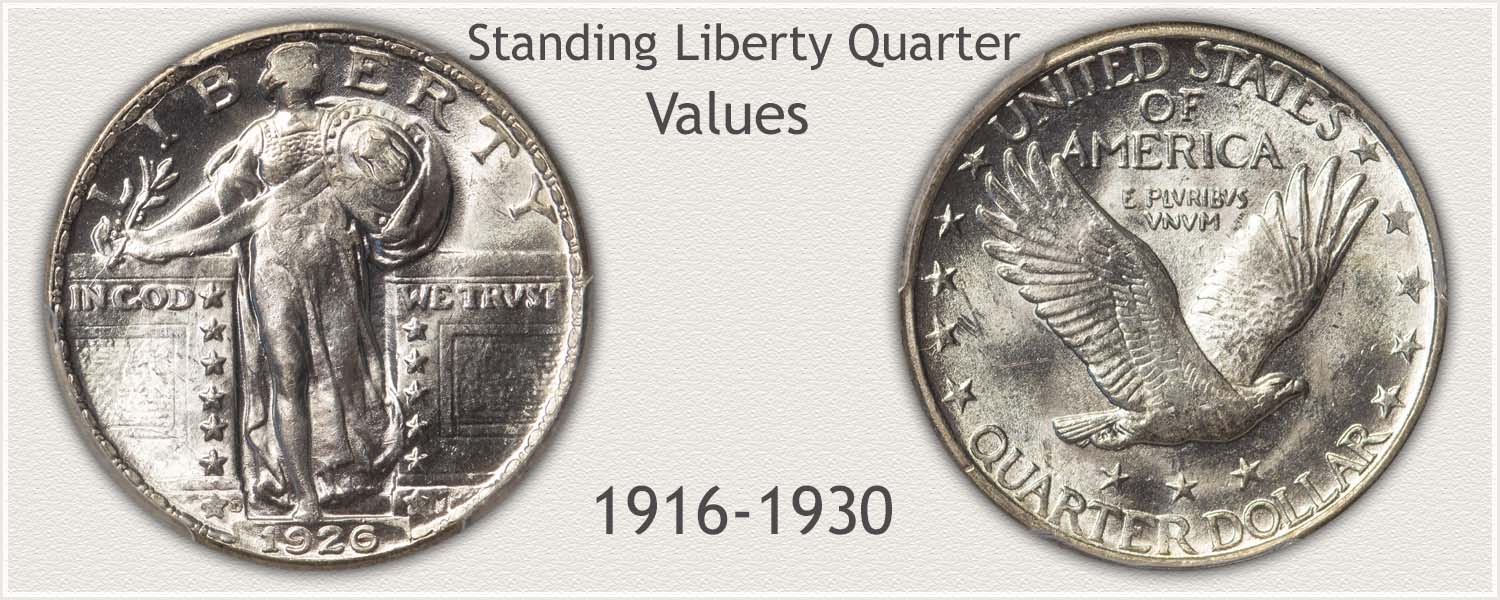
Steps Leading to Value:
- Step 1: Date and Mintmark Variety - Accurately identify different varieties and dates spanning the Standing Liberty quarter series.
- Step 2: Grading Condition - Important elements are judged and condition is graded.
- Step 3: Special Qualities - These old quarters are 90% silver and many factors contribute to value.
The following value chart shows clearly collectors pay a premium for higher-grade coins. Examine your coins closely for dates, mint marks, and condition. Proceed through the steps, each plays an important role in determining accurate values.
| Standing Liberty Quarter Values 1916 to 1930 | ||||
|---|---|---|---|---|
| Condition of Coin | ||||
| Date | Good | Fine | Extremely Fine | Mint State |
| Standing Liberty Quarter Values Updated | 4/7/2025 | |||
| 1916 | $3,053 | Rare | Rare | Rare |
| 1917 | $20 | $51 | $114 | $308 |
| 1917 D | $32 | $76 | $104 | $370 |
| 1917 S | $32 | $92 | $151 | $392 |
| Type II - Stars Below Eagle on Reverse | ||||
| 1917 | $21 | $47 | $72 | $177 |
| 1917 D | $44 | $79 | $106 | $342 |
| 1917 S | $68 | $95 | $134 | $255 |
| 1918 | $19 | $30 | $54 | $201 |
| 1918 D | $25 | $61 | $108 | $314 |
| 1918/7 S | $1,702 | $2,524 | Rare | Rare |
| 1918 S | $21 | $35 | $76 | $212 |
| 1919 | $20 | $50 | $67 | $252 |
| 1919 D | $49 | $210 | $490 | $1,369 |
| 1919 S | $81 | $185 | $492 | $1,807 |
| 1920 | $11.45 | $31 | $41 | $213 |
| 1920 D | $87 | $141 | $187 | $928 |
| 1920 S | $23 | $28 | $67 | $456 |
| 1921 | $114 | $243 | $336 | $1,257 |
| 1923 | $11.80 | $27 | $46 | $165 |
| 1923 S | $262 | $493 | $1,096 | $2,238 |
| 1924 | $11.45 | $23 | $42 | $153 |
| 1924 D | $32 | $79 | $129 | $228 |
| 1924 S | $36 | $50 | $121 | $512 |
| 1925 | $5.69 | $7.72 | $40 | $167 |
| 1926 | $5.69 | $7.23 | $39 | $174 |
| 1926 D | $7.23 | $27 | $58 | $186 |
| 1926 S | $5.69 | $10.53 | $82 | $461 |
| 1927 | $5.69 | $7.23 | $37 | $150 |
| 1927 D | $10.53 | $35 | $143 | $240 |
| 1927 S | $33 | $129 | $540 | Rare |
| 1928 | $5.69 | $7.23 | $36 | $174 |
| 1928 D | $5.69 | $7.72 | $40 | $197 |
| 1928 S | $5.69 | $7.72 | $43 | $167 |
| 1929 | $5.69 | $7.23 | $33 | $153 |
| 1929 D | $5.69 | $7.72 | $35 | $184 |
| 1929 S | $5.69 | $7.23 | $36 | $154 |
| 1930 | $5.69 | $7.23 | $32 | $155 |
| 1930 S | $5.69 | $7.72 | $38 | $171 |
The above are wholesale Standing Liberty Quarter values. Computed from dealer's price lists with various mark-up factors figured in. They reflect closely the value you would expect to receive when selling.
However; do expect variations in value to occur subject to subtle grading points, collector demands and dealer needs.
Step 1: | Date - Mintmark Plus Variety are Identified
A full figure of Liberty is featured on the new quarters of 1916. The design is very popular with collectors and the series is collected in all grades. Liberty is holding an olive branch (peace) and shield (protection). She is "stepping forward to the gateway of the country" as describe by the mint. Historical context is WWI at the time and US involvement in keeping the country secure. Reverse is an eagle in flight surrounded by stars.
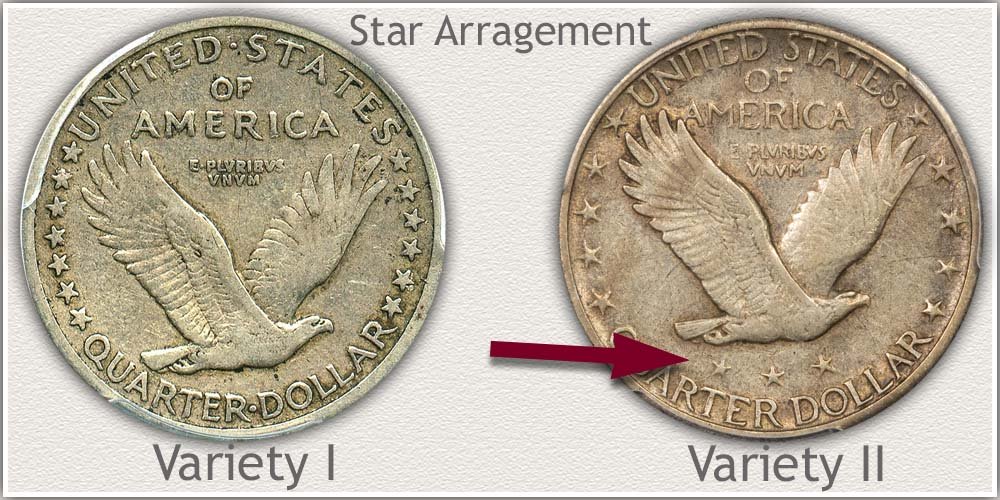
A second variety soon replaced the first. Part of 1917 production introduced changes to Liberty adding armor to her gown. Additionally, and easiest to identify the new variety, are the thirteen stars on the reverse were modified to 5 stars either side of the eagle and 3 below. These changes remained throughout the series.
Mint and Mintmarks of the Standing Liberty Quarter Series
The need for quarters was met by three mints, Denver, San Francisco, and Philadelphia. All combined to produce over 226 million Standing Liberty quarters.
Numbers struck by each mint varied year by year creating both available and scarce date and mintmark combinations. Typical collections include all dates and mints and this demand identifies the scarce issues by higher values on the chart.
San Francisco Mint
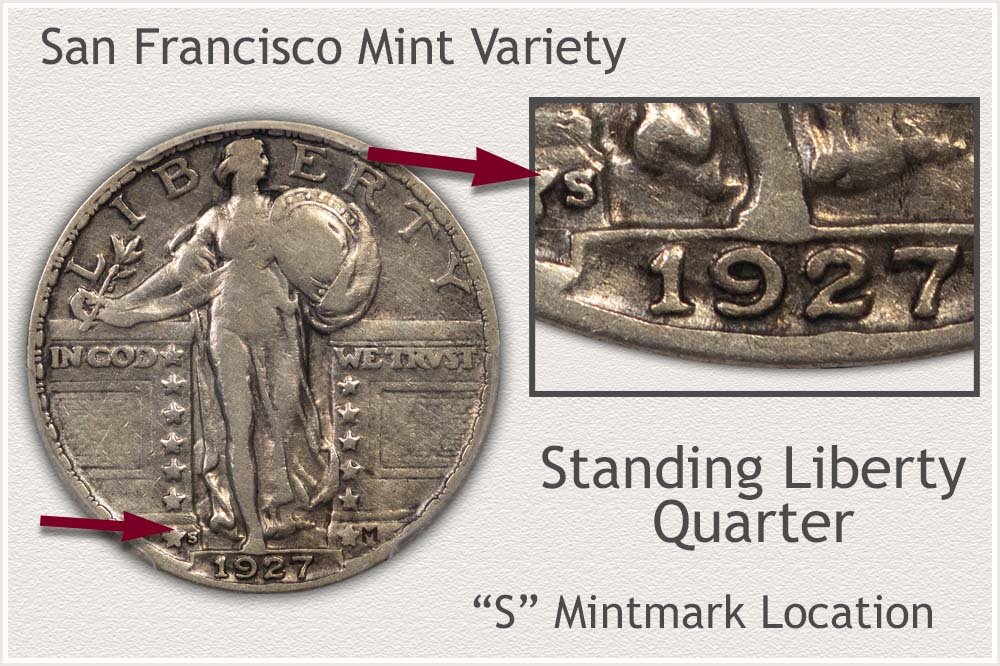
San Francisco mint began striking Standing Liberty quarters in 1917 of both varieties. Production was typically on average 2 million per year. 1927 is the low mintage year of 396,000 pieces, creating a scarce variety, and also the second lowest of the entire series.
Indicating the San Francisco mint is a small "S" mintmark left of Liberty's foot near the date.
Denver Mint
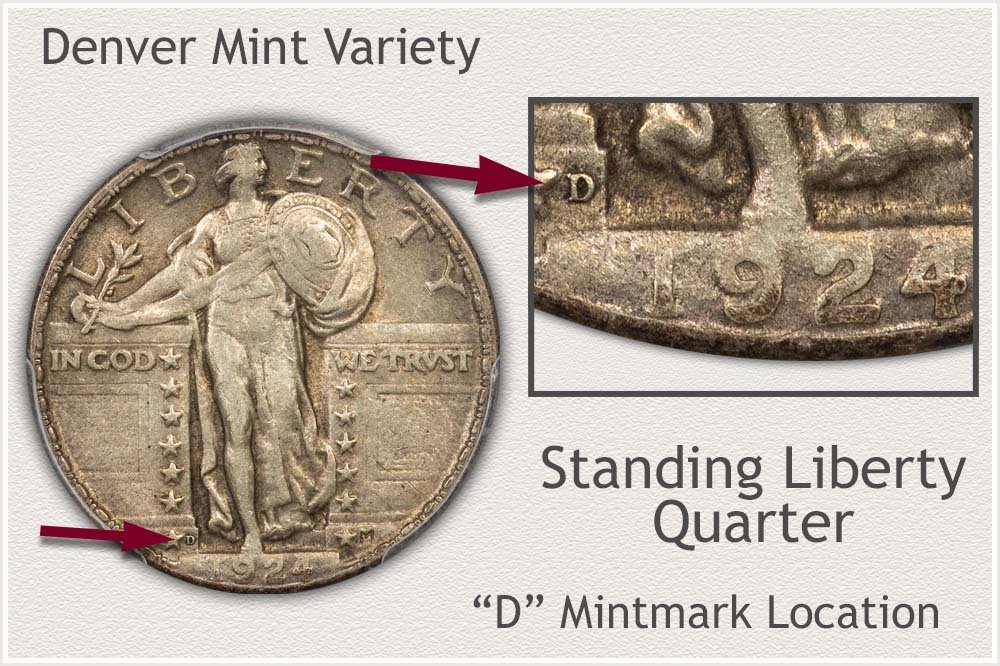
A great many of the Denver mint issue Standing Liberty quarters are the scarce variety for that year. Denver's total number minted of the series is just over 29 million quarters the lowest total of the three mints. Mintmarks are very small; a magnifying glass is helpful. These mintmarks are necessary to identify when placing an accurate value on the coin.
Look closely left of the date, near the star. A small "D" is the mintmark used by the Denver Mint.
Philadelphia Mint
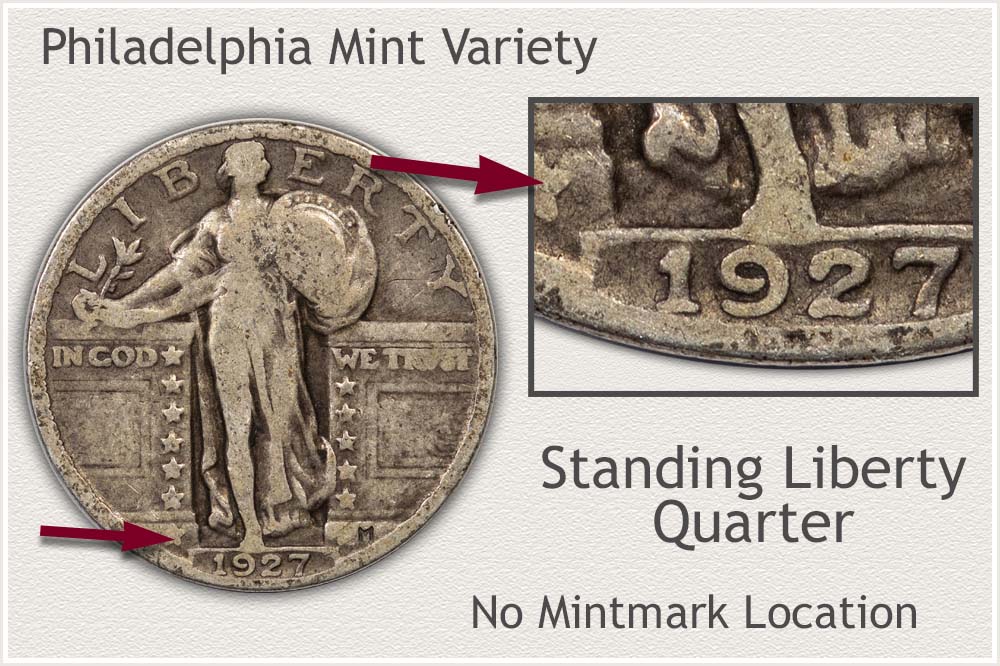
Philadelphia mint is the main US mint, striking coins, assaying metals, and producing all dies used by other mints. Additionally, striking the largest number of Standing Liberty quarters. Philadelphia variety quarters are an affordable entry into the series. Two dates standout as scarce and high value, 1916 and 1921 both low production years. 1916 is key to the series only 52,000 minted.
Philadelphia did not use any mintmark. No mintmark in the space left of the date near the small star is a Philadelphia quarter.
Step 2: | Grading Condition | Determine Value
Dealers and collectors look at the condition of coins very closely and determine the "Grade". This is done first before determining Standing Liberty quarter values.
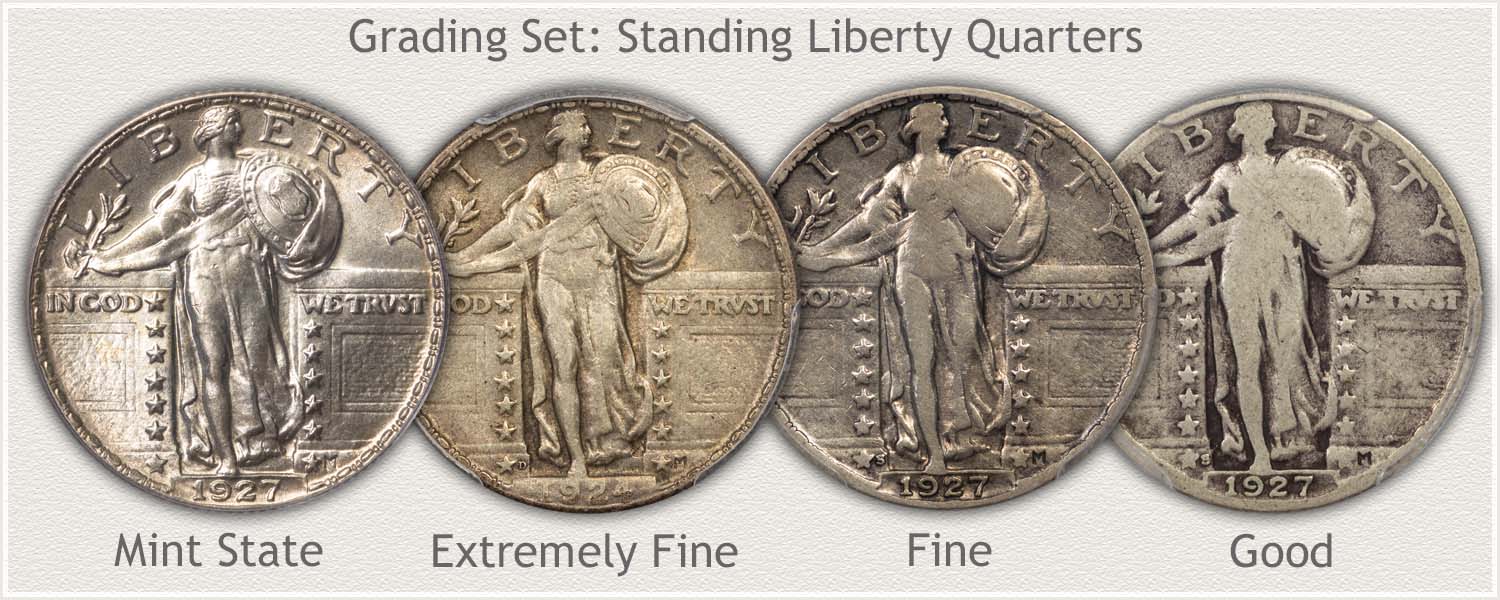
Standing Liberty Quarter Values are Conditional
As a coin circulates and wears each stage of wear is different and assigned a grade. A range of grades are used; from a heavily worn coin "Good" condition to one bright and new in "Mint State" condition.
Comparing your coins to the grading images below, notice how wear causes a different appearance to the coin. As example, when first minted, Liberty is holding a finely detailed shield. Wear reduces these details on and around the shield and the progression of wear helps identify an accurate grade. Certain design elements diminish or disappear when worn. These recognizable differences are used to judge and grade a coin.
Mint State Grade: Standing Liberty Quarter
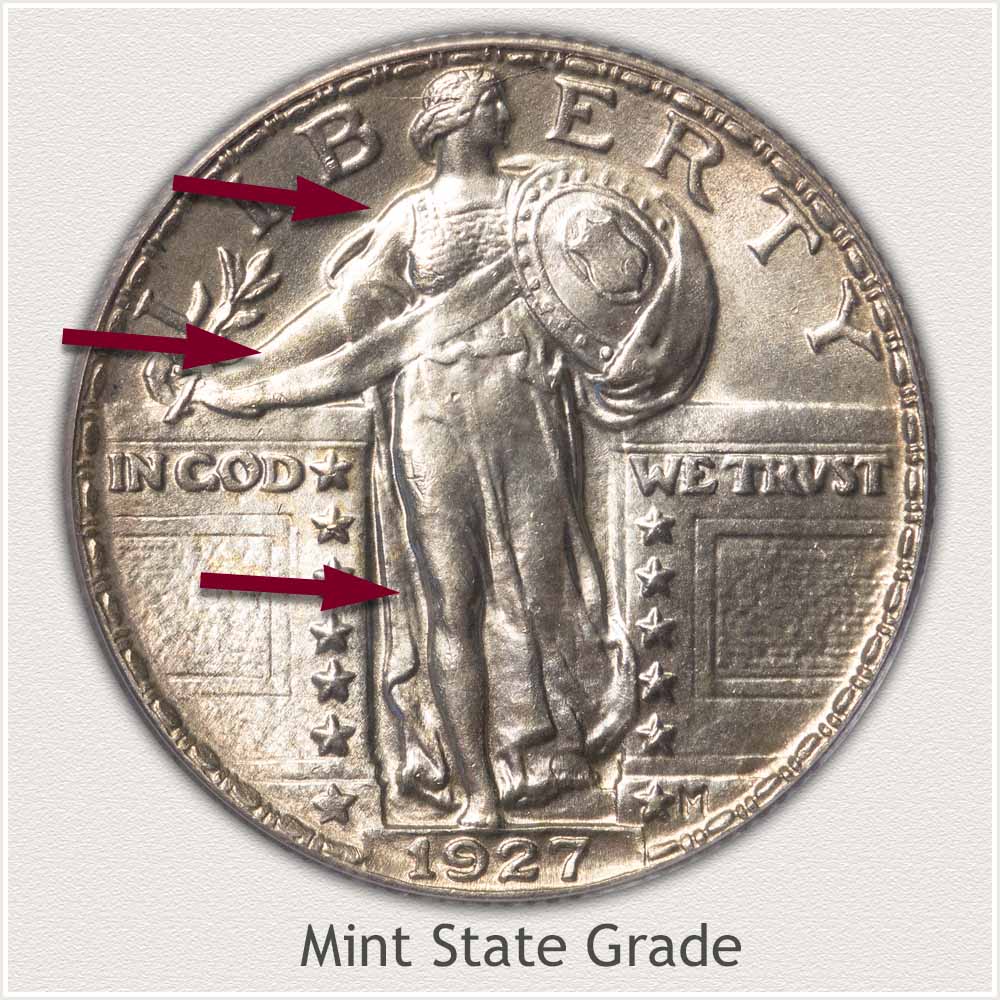
Obverse: Features Identifying Mint State Grade: Reaching the high grade of Mint State defines the condition as no wear to the surface. Areas high in profile are examined to detect the smoothing and change in texture wear presents.
Liberty's right chest is judged, fine grains to the metal and complete fine detail and no removal of metal indicates no wear to the surface.
A scarf is held in her right hand extending across Liberty to the shield. It is without any smoothness, remaining the same shine as metal above and below.
Examine her right knee for any signs of dulling to the metal, a sign of wear.
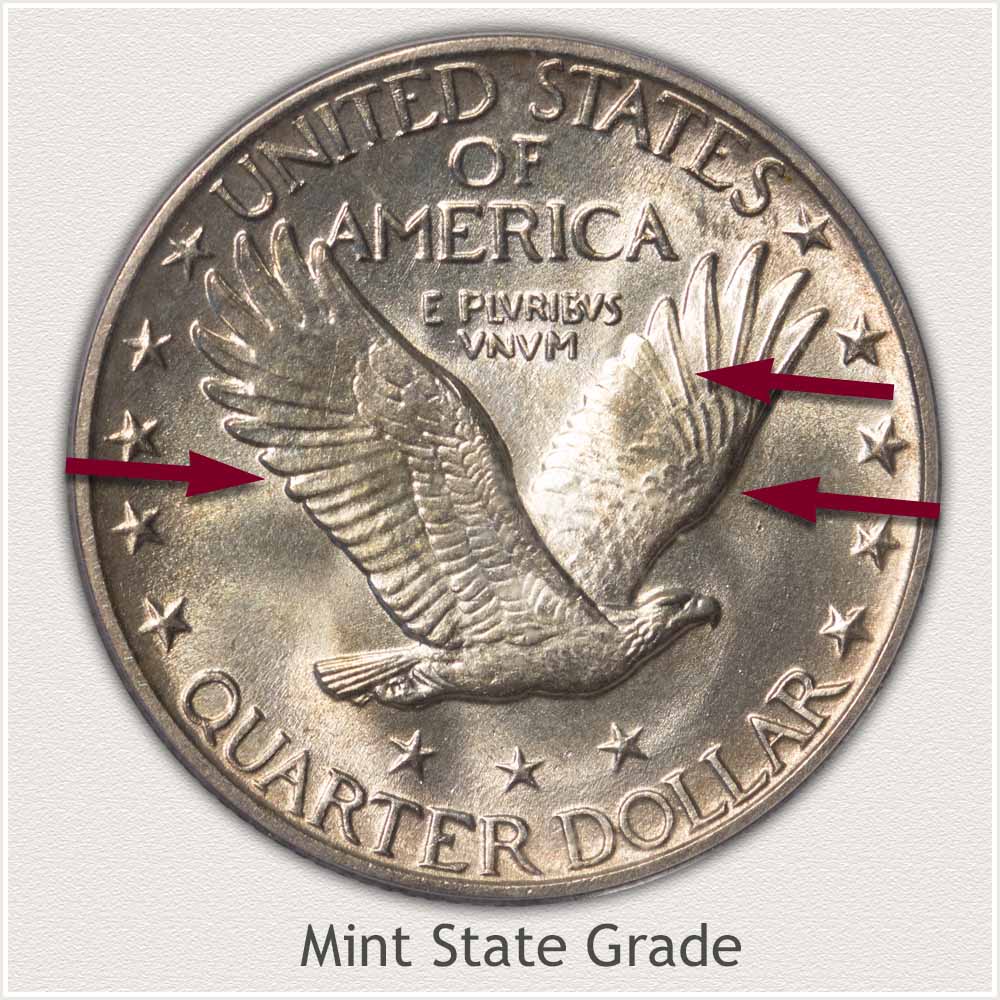
Reverse: Features Identifying Mint State Grade: Luster that produces the "shine" of a mint state grade coin is a fine texture.
Eagles left wing is prone to removal of original luster. Towards the center of the wing, confirm a consistent texture remains.
A high relief contour is part of the Eagle's left wing from the tip to the body of the eagle. Judge the surface along the upper edge to detect smoothing caused by wear.
Fine line ridges are center details to feathers, these are bright and the same texture as the rest of the wing.
Extremely Fine Grade: Standing Liberty Quarter
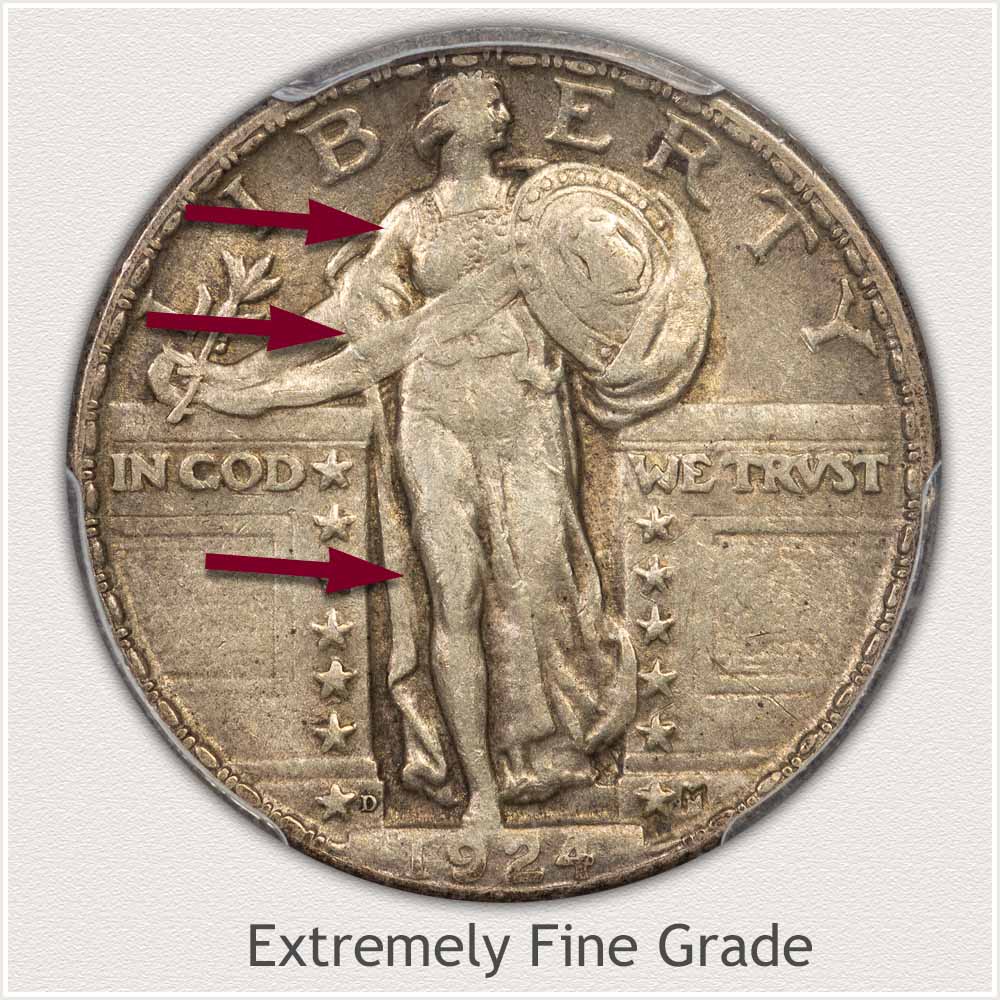
Obverse: Features Identifying Extremely Fine Grade: An Extremely Fine condition quarter features most major designs elements bold and finer details slightly faded.
Liberty, from head to toe, is lightly worn on the very upper areas. Her right chest is smooth but does not connect with the scarf just below.
A good indication of minimal wear is the scarf remains full with upper and lower lines as it crosses Liberty.
A small flat area is noted on Liberty's right knee, thigh, and continues to her toe. This flat area is confined to just the upper contour of the leg leaving depth to the sides.
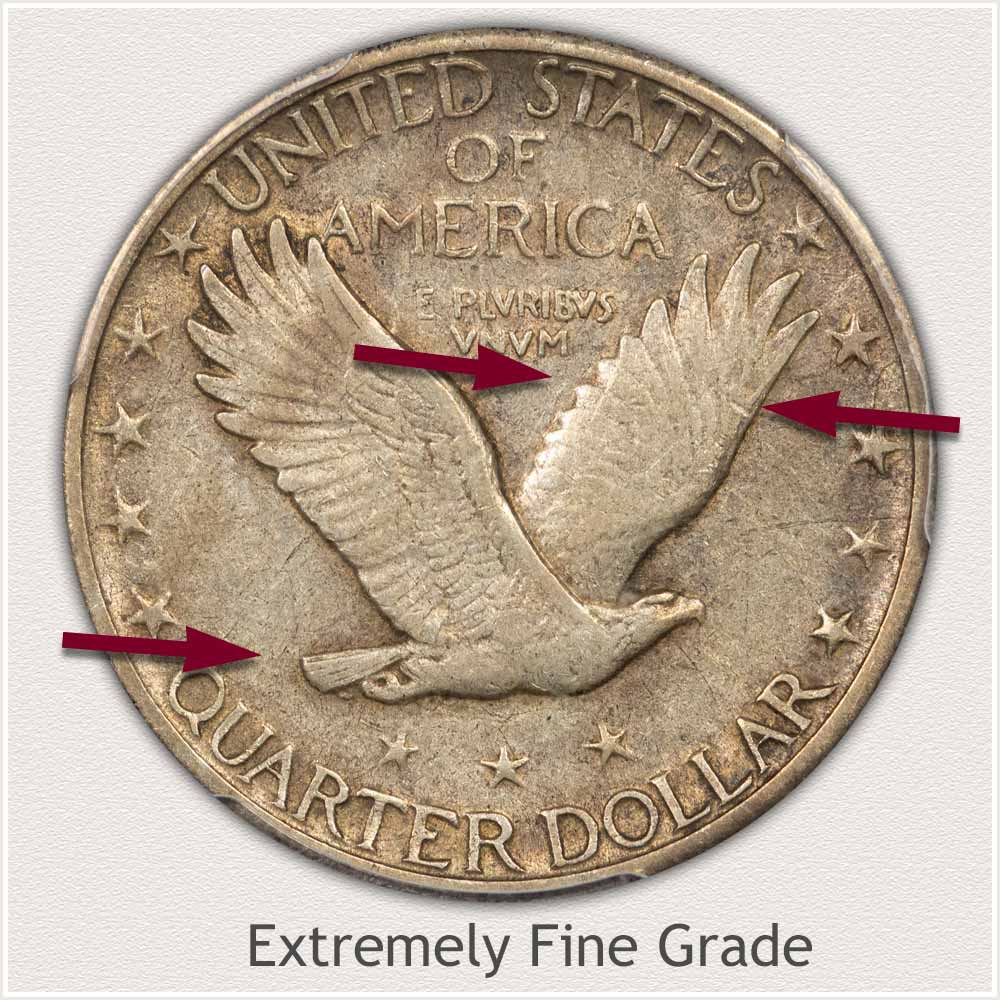
Reverse: Features Identifying Extremely Fine Grade: A large amount of wing detail remains, presenting a bold eagle design.
A key focal point to identify the Extremely Fine grade is the Eagle's left wing. Towards the front edge of the wing, lines representing each feather remain just visible. These lines identify a row of feathers different than the large flight feathers.
A well detailed left wing remains with all feathers separate and bold.
Tail feather design is worn across the top edge with one or two feather lines remaining.
Fine Grade: Standing Liberty Quarter
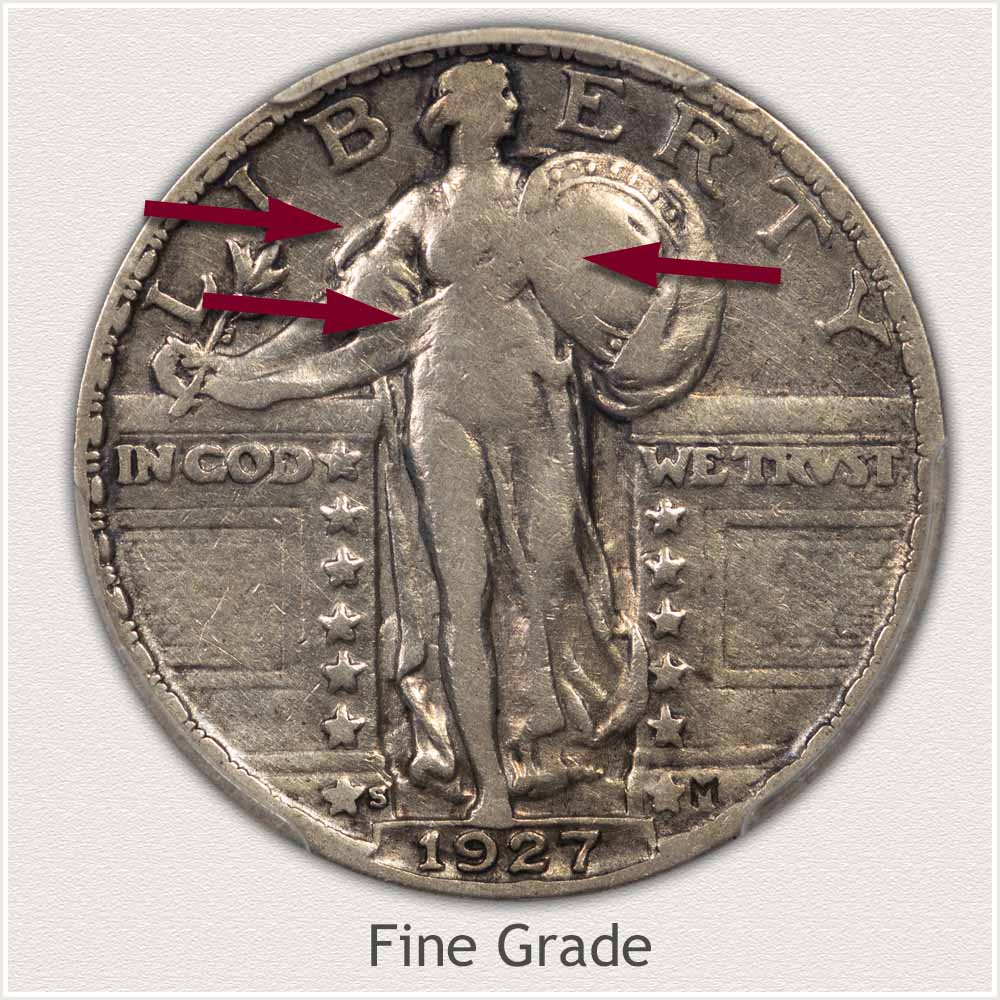
Obverse: Features Identifying the Fine Grade: Wear has removed most of the highest points of the design, leaving a lack of detail.
Although the sides of Liberty remain raised, across her center is now flat. A broad flat surface is continuous from Liberty's toe to neck line.
A once defined scarf from hand to shield is now indistinct across Liberty.
Keeping this coin within the Fine grade is the shield edge remains separated from Liberty.
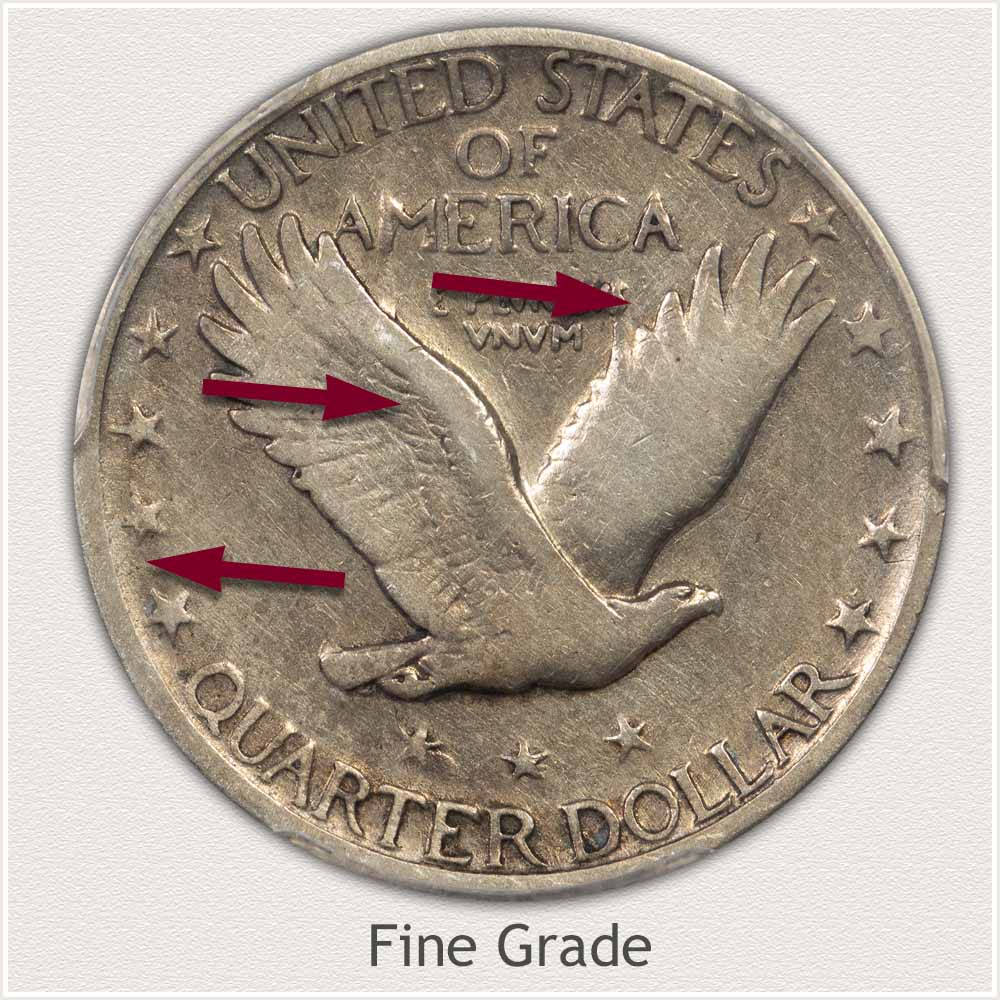
Reverse: Features Identifying the Fine Grade: All high contour areas of the Eagle's wing are now flattened.
The left wing is lacking most inner feather detail. Edges of feathers are bold only at the very ends.
Leading edge of the right wing is now noticeable flat. Flatness is also showing at the tips of the feathers. Raised edges separating feathers are distinct only within the center of the wing.
A full rim remains with letters of the legend bold. Stars are raised from the field.
Good Grade: Standing Liberty Quarter
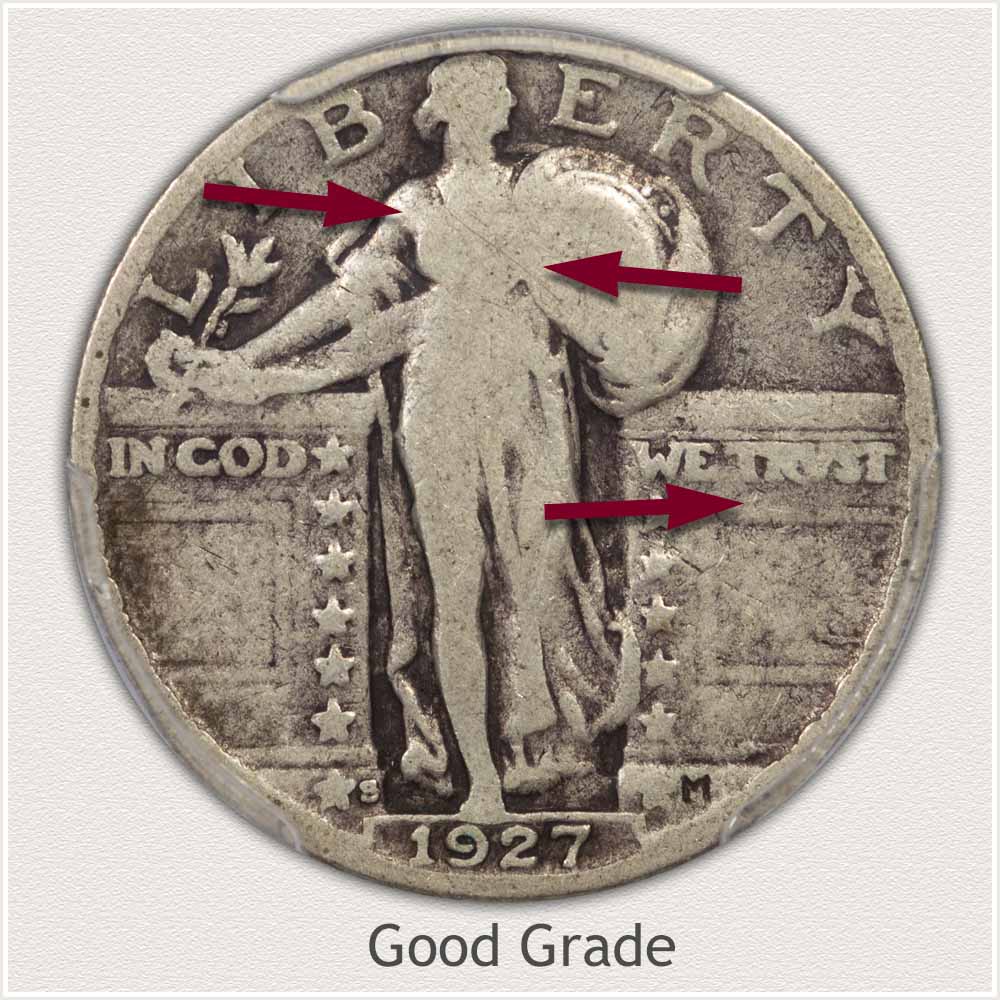
Obverse: Features Identifying the Good Grade: Areas of the coin have now become hard to recognize. Wear has removed enough metal to flatten all high point contours.
Liberty is worn smooth over her entire center, leaving only gown detail towards her feet.
Shield is fully connected as a flat area to Liberty, only slight detail remains of the upper edge to shield.
Lettering is readable. Letters of "Trust" are becoming weak.
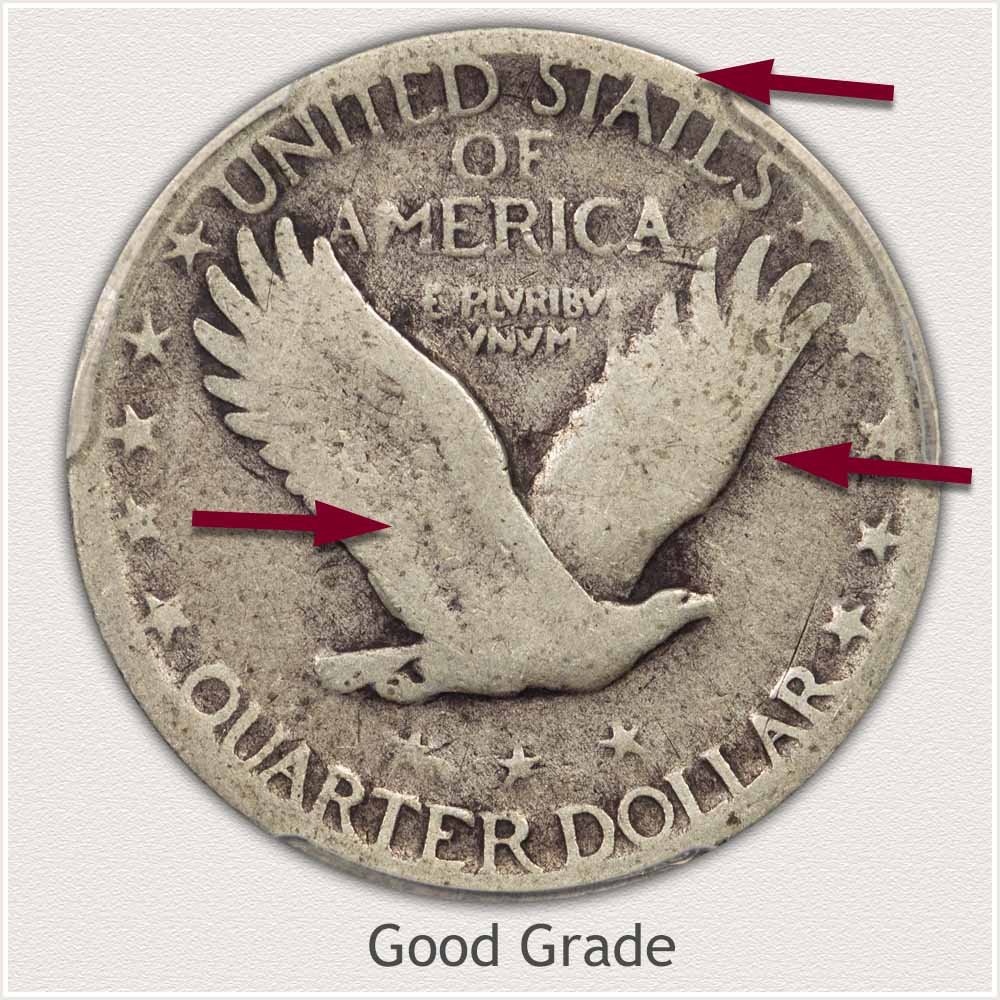
Reverse: Features Identifying the Good Grade: Most details to the eagle are worn smooth.
A complete outline to the eagle remains. Feathers to the left wing are now smooth, no edged details remain.
Central feather detail is just visible to the right wing. Ends to the feathers are all blended.
Letters along the rim have become faint in areas with a few tops of letters merged to the rim. Stars are faint in areas.
How to Video: Grading Standing Liberty Quarters
Continue the grading process. Video plus images and descriptions add to the understanding of condition. An important part of value and judging collector quality coins.
In Depth Page and Video | Grading Standing Liberty Quarters
Step 3: | Special Qualities Determine Value
Quick Check: Is your coin Bullion or Collector; Standing Liberty Quarter Value? The condition of the date area is a solid indicator defining a bullion or collector piece. 1925 saw a modification in the design, by recessing the date and improving its ability to remain readable.
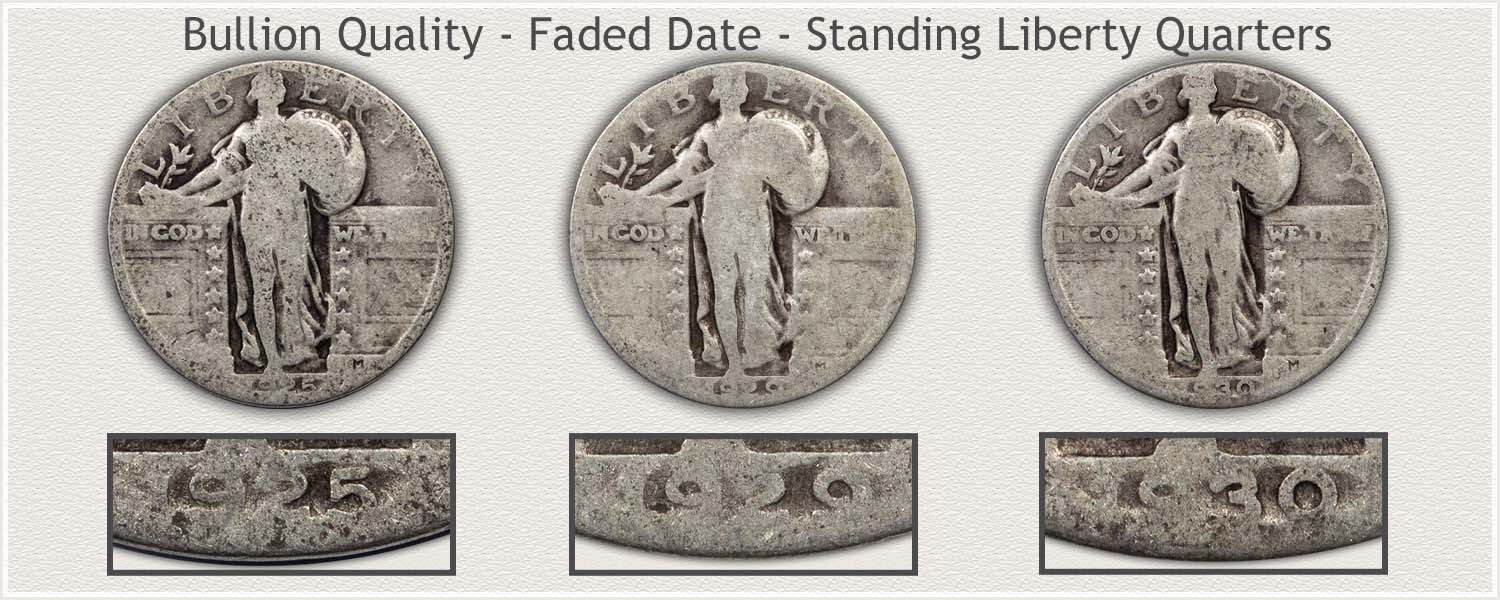
The majority of bullion quality and value quarters are of the 1925 to 1930 sub-variety with recessed date. If the date is faded with numbers incomplete it's easily seen as below Good grade, becoming bullion quality. Note: watch for the 1927-S a premium scarce date. Compare your post 1924 quarters with the images to confirm a collector quality coin. Standing Liberty quarter values are $5.69 as of 4/7/2025 for coins 1925 to 1930 in Good and below grade.
Recognizing Aesthetic Appeal of Standing Liberty Quarters
Collectors are keen to spot eye appealing coins to add to their collections. Viewing the example coins each is judged in overall look and desirability.
Noticeable Corrosion
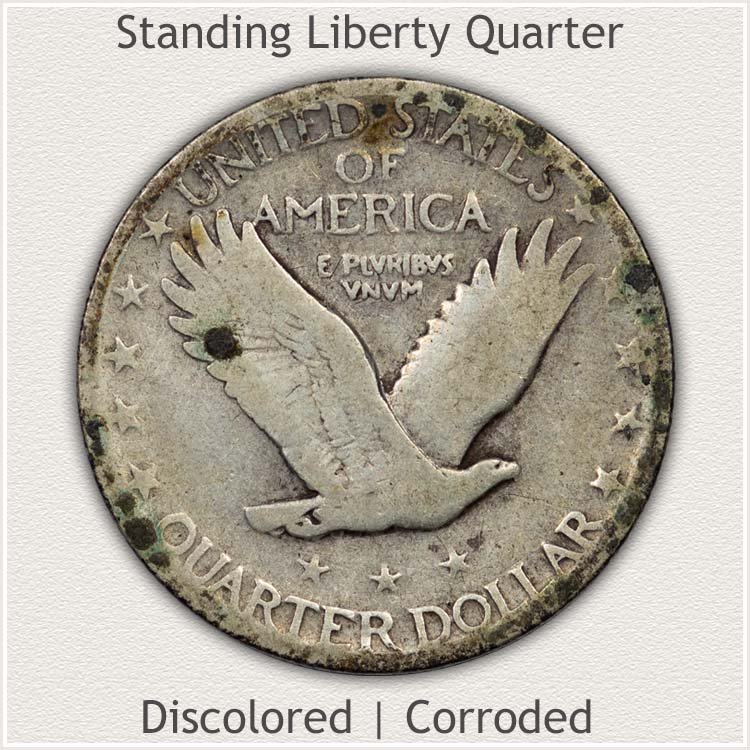
Notice the dark spots scattered over the surface of the coin. They indicate poor storage, likely humid and allowing corrosion to take hold. A low appealing coin to a collector.
Noticeable Cleaning
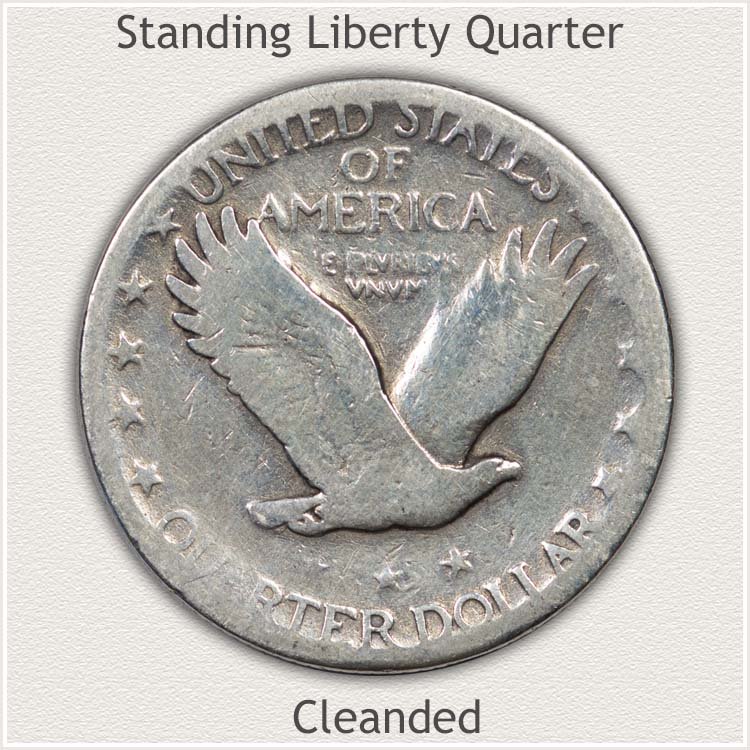
An attempt was made to clean this coin and "improve" its surface. A cleaned coin is judged for what it is and quickly passed by a collector. Any value as a collectible is "washed" away.
Noticeable Appeal
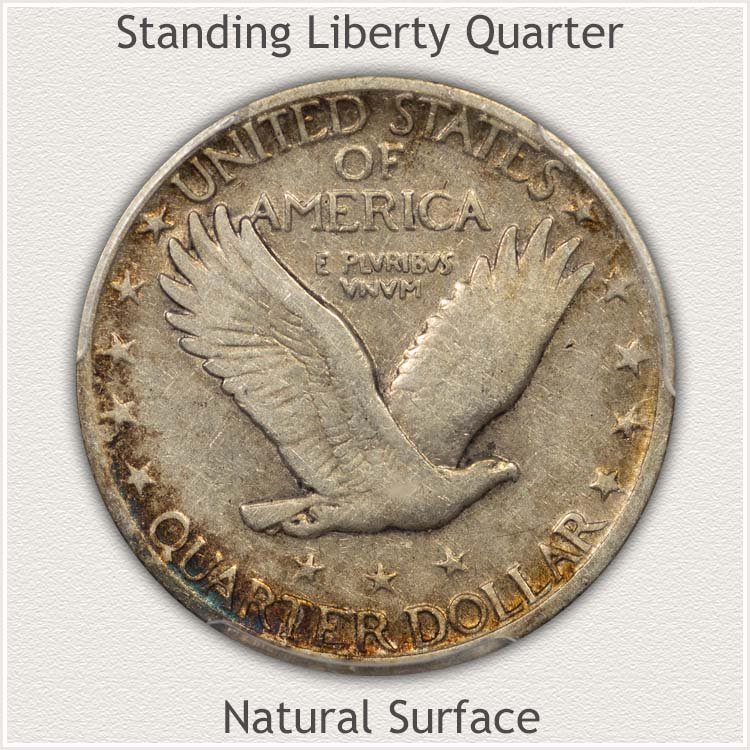
Here a coin is worn to the same extent as the prior coins. A big difference is when set aside it was protected, no further deterioration, and left to age naturally. Eye appeal is positive and recognized by collectors, preserving value.
References
US Mint. Catalogue of Coins of the United States.
https://nnp.wustl.edu/library/book/554591
US Mint. 1916 US Mint Annual Report.
https://nnp.wustl.edu/library/book/514129
US Mint. 1934 US Mint Annual Report.
https://nnp.wustl.edu/library/book/514138
US Mint. 1917 US Mint Annual Report.
https://nnp.wustl.edu/library/book/514130
Coin Values | CoinStudy Articles
Date by Date
In Depth Standing Liberty Quarter Values
1917 to 1930
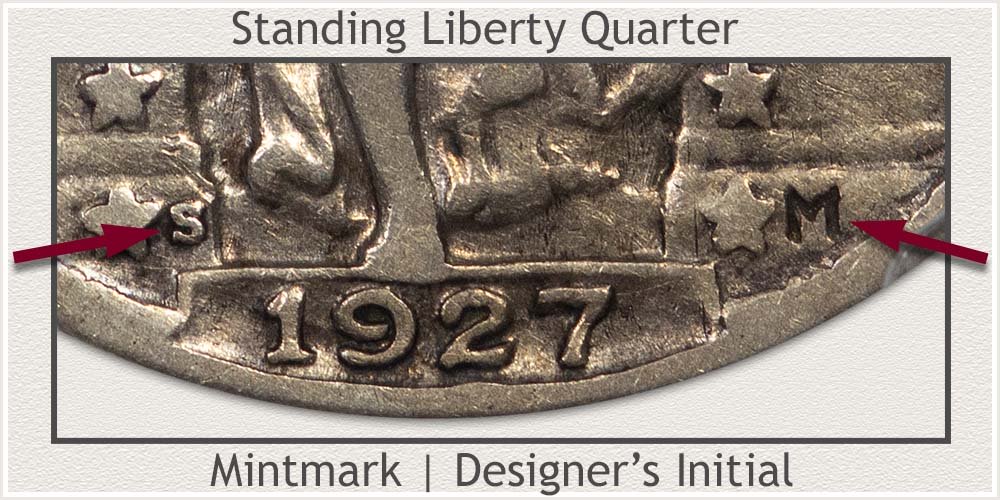
The "M" next to the date. On the right side of the date is a block letter "M" impressed into the design. Hermon A. MacNeil designed the Standing Liberty quarter and his initial "M" is on all quarters of the series. The initial is of the same size as a mintmark but recognizes the creator of the design.
Coin Value Guide | How to Value a Coin Collection
A step by step method combined with the coin value online guide identifies how to value a coin collection. Discover how much your box of old coins is worth.
Easily find how much your old coins are worth. From Bust Quarters to Seated Liberty, Barber, Standing Liberty and Washington quarters. All series include Grading Images to judge the condition of your coins and coin value charts.
Most quarters dated before 1892 are very scarce. Twentieth century quarters; the Standing Liberty and Washington series have their share of rare and scarce dates. Leading to a find is often recognizing an above average condition quarter.
Today's Minimum Silver Coin Values
Many of your old US silver coin values are tied closely to the price of silver. Pre 1965 silver dimes, quarters, half dollars and silver dollars are all heavy with 90% silver and worth many times their face value. With today's high value of silver; $30.08 per ounce as of 4/7/2025 your old quarters are becoming surprisingly valuable.
Determine the value of more old coins.
A quick reference to US Coin Values. Images to identify each coin and minimum values for each type. Using the step by step method to how much coins are worth. Bookmark the online value charts to phone.
Understanding value of your Standing Liberty quarters is a great first step to successfully selling these coins. Resources helping find markets is the next step.
★ Coin Values Discovery finds Standing Liberty Quarter Values and...
All old US coin values. It is an excellent index with images and text links to all coin series, from Cents to Gold. Value charts, grading images and a step by step procedure uncovers how much your box of old coins is worth.
